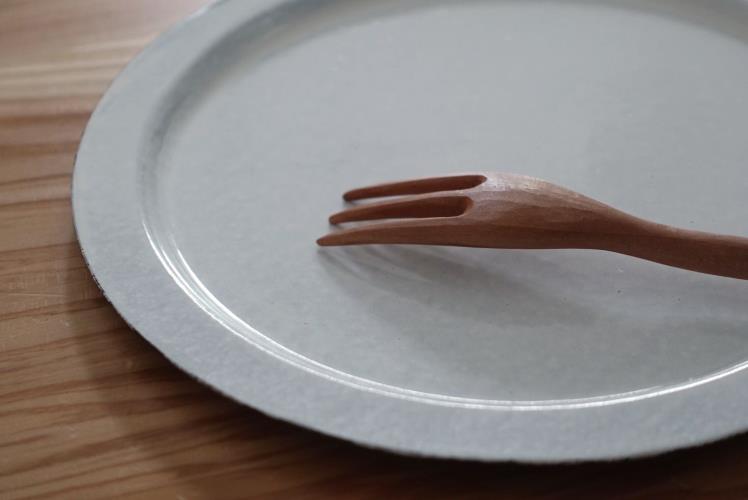Japan-based writer and traveller, specialising in design, lifestyle and travel journalism. Ron previously served as an editor of MING Magazine, ELLE Decoration and CREAM.

Enamel plate made by Masaki Kanamori and wood fork by Ryuji Mitani
“These objects don’t have the right body ratio,” a gallery owner told me one day. I looked at the objects, feeling that there was indeed something wrong, but couldn’t quite put a finger on it. After a while when I was meeting my friends who were craftsmen, it occurred to me that today most craftsmen no longer pay that much attention to the right body ratio, such as vertical edges and right angles, etc. In the discussion, I noticed that what craftsmen today are pursuing is the “yurui” aesthetics.
“Yurui” (ゆるい) means inattentive and sketchy in Japanese. It’s used to describe furniture with some flaws. In recent years, young people use it to describe life attitude. Some use it to describe peaceful and contented life attitude, while some use it to describe one that is reckless. This word is also used to describe arts recently.
The “yurui” aesthetics is inattentive. It doesn’t overly pursue for perfection and completeness. For instance, generally a circle is drawn using a compass. But when it comes to “yurui” aesthetics, the circle is drawn with bare hands. There will always be slightly different in each circle’s diameter, but it’s also these differences that make people feel comfortable. Cups without perfect symmetry are acceptable in “yurui” aesthetics. A sculpture with a blurry face can actually convey more emotions. Inattentiveness in fact comforts the audience.
However, when an object is too “yurui”, it might go extremes and give people the impression of being crude. In this sense, it’s quite a challenge for craftsmen to strike a good balance between “perfection” and “sketchiness”. As far as I know, Japanese wood designer Ryuji Mitani and gold craftsman Masaki Kanamori are two of the craftsmen who rise up to the challenge. Ryuji Mitani is quite a famous craftsman in Japan. Every time he held an exhibition, his wood works would be sold out in a short time. I myself have a wood fork made by Ryuji Mitani. Since it’s hand-made, it’s actually a little bit askew. With fair lines carefully carved on the handle, the wood fork is very skin-friendly and feels very well in the hand. Ryuji Mitani’s wooden dish is often “imitated” by young craftsmen. Surprisingly, no matter how identical they are, Ryuji Mitani’s wooden works always let people feel more comfortable.
Masaki Kanamori is the first Japanese craftsman to turn enamel products into handicrafts. For a long time, enamel products have been seen as industrial products. No matter what colour they are, pale white or colourful, you shall always expect to see the colours evenly spread on the surface. As a matter of fact, colour evenness has become a basic standard to evaluate an enamel product. However, Masaki is bold enough to break away with the “norms”. With unevenly-spread enamel glaze, his white enamel ware often manifests some dark shades. As a result, the entire enamel ware looks like cloud and mist and gives people a poetic sense, which is quite appealing to the eyes. In the past, salad bowls are often made with wheels. Therefore, their iron matrixes look like a perfect semi-circle. However, Masaki is quite annoyed by such “perfection”. He prefers to polish the matrix with bare hands and add more concave-convex textures to them. Although human eyes can hardly see these textures clearly, they render a special, soft and warm feeling.
The trace of the “yurui” aesthetics can be seen not only in handicrafts, but also in everyday life and store management philosophies. When Ryuji Mitani opened his store & art gallery “10cm”, he gave up traditional plan-centred store management philosophies. He didn’t make clear schedule of the exhibition at the art gallery and didn’t determine the direction towards which activities should follow. Another selected shop “22” in Nagoya is widely known as a fashion store. However, its store owner Toshiko Iwada is quite free with the management of the store. Although the store is just about several-hundred-feet long, customers can find a variety of goods there, including clothes, books, handicrafts made by mentally or physically disabled people. Both “10cm” and “22” manifest the life attitudes of their owner exactly through their “yurui” aesthetics.
It seems the “yurui” aesthetics was nurtured when the bubble economy burst in Japan. After the bubble burst, Japanese people began to cast doubt on the traditional aesthetics that featured luxury and magnificence. Gradually, people began to form new attitudes towards the nature of life. Compared to boutique products, people pay more attention on the products complying with nature. The other days, I paid a visit to ceramic artist Takashi Suzuki and was especially impressed by something he said, “Well, products that are cool and perfect certainly reveal a life attitude that prefers to be cool and perfect. Indeed, many people find such life attitude appealing. However, sometimes, people might get really a little rustic and lazy. On such occasion, isn’t it just fine to be lacking in something, to be not that perfect?”